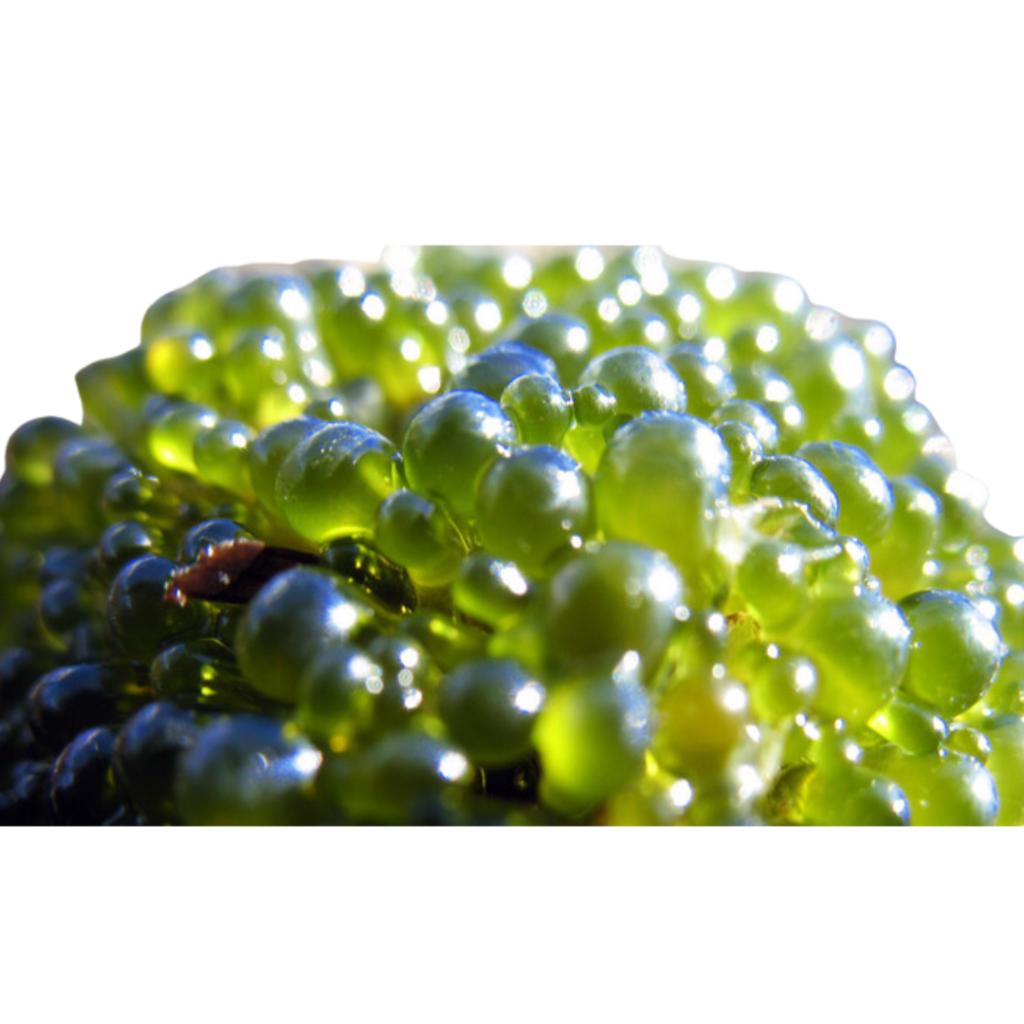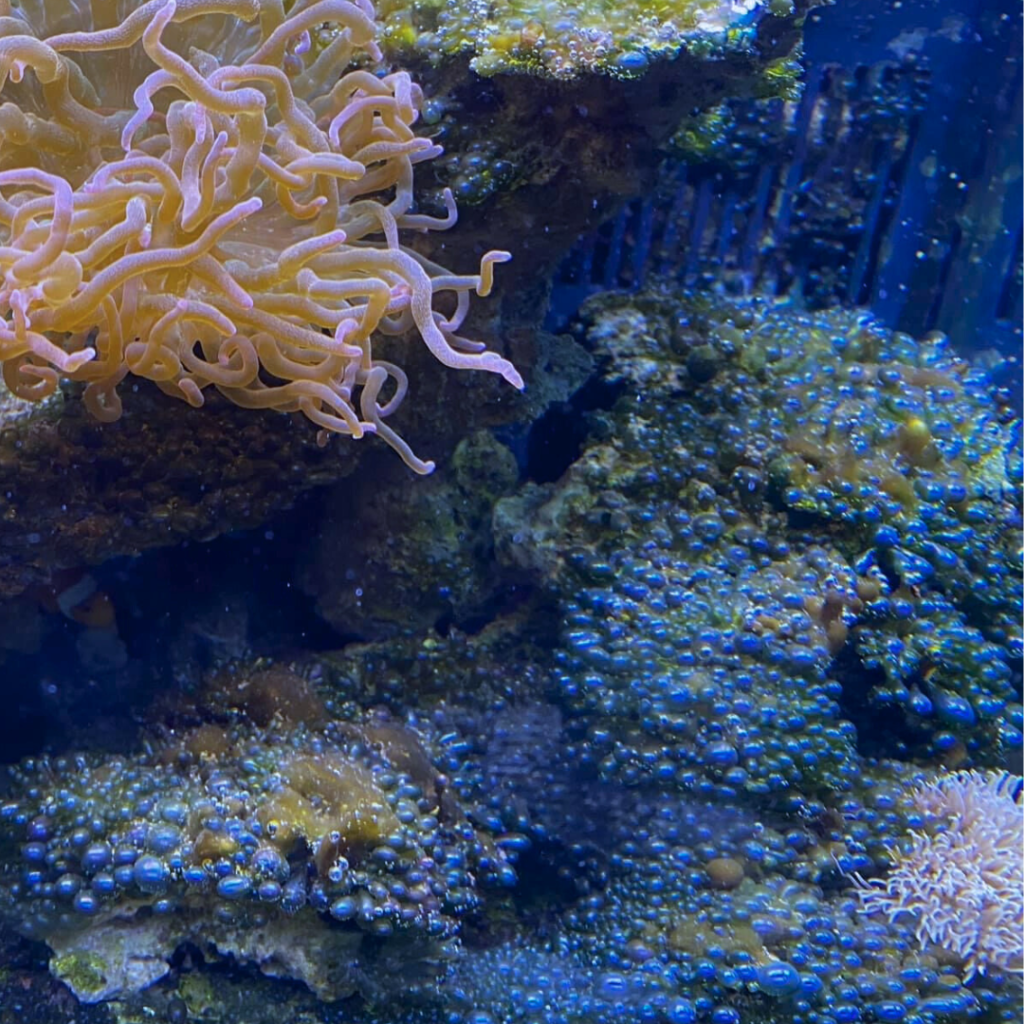Dealing with bubble algae can be a daunting task for aquarium enthusiasts. This stubborn green alga is notorious for its rapid growth and tough, balloon-like structure. In this blog post, I will delve into the nature of bubble algae, its impact on your aquarium, and most importantly, how to get rid of bubble algae.
Scroll to the bottom of the article to read my personal experience and how I quickly got rid of bubble algae in my reef tank using a combination approach consisting of Emerald crabs, nutrient reduction, and manual removal!
What is bubble algae

Bubble algae are a type of macroalgae commonly found in marine and reef aquariums. They manifest as small, dark green, spherical algae bubbles that can reach up to 2 inches in diameter.
The bubbles have a shiny appearance and can vary in size. Although they may appear harmless initially, their rapid growth and durable cell walls make them difficult to eliminate, potentially leading to an overgrown and unsightly tank.
Causes of Bubble Algae Infestation
These algae with bubbles often infiltrate your aquarium via live rock, coral frags, or even by hitchhiking on equipment. They flourish in nutrient-rich environments, so an excess of nutrients such as nitrates and phosphates can promote their growth.
Other contributing factors include inadequate water flow, which allows detritus to accumulate, and insufficient light, which can lead to imbalances in your aquarium’s ecosystem and favor the growth of bubble algae over other photosynthetic organisms.
Bubble algae can form from a variety of sources, so identifying the root cause for the algae is essential for eliminating it from your tank.
You May Also Like: How to Cycle a Saltwater Tank
is bubble algae bad?
When I first found bubble algae in my reef tank, I wondered if the green bubbles would pose a threat to the health of my fish and corals. However, Bubble algae isn’t necessarily bad, but having it present in your saltwater tank can create an unwelcoming sight. Even though they are not bad for your tank, I had a batch of bubble algae growing in my zoanthinds, causing them to close up.
While bubble algae aren’t toxic to fish or corals, they can cause a range of problems in your tank, including:
- Competing with corals for space and light: As bubble algae grow, they can shade corals and limit the amount of light they receive, hindering their growth and overall health.
- Disrupting the aesthetic appeal of your aquarium: Large infestations can be unsightly, making it difficult to appreciate the beauty of your corals and other inhabitants.
- Potentially damaging coral by growing over them and causing tissue damage: The strong cell walls of bubble algae can irritate and damage coral tissues, which can lead to stress, disease, and even death.
HOw to get rid of bubble algae

Getting rid of bubble algae can be challenging, but with perseverance and the right approaches, you can effectively eliminate them from your aquarium. The following methods of bubble algae removal have been used for many years by professionals in the saltwater tank hobby.
As aways we recommend to never make any sudden changes to your tank as that may shock its inhabitants leading to an undesirable outcome for your finned friends.
Manual Removal:
Gently remove the bubble algae by hand, using tweezers or specialized algae scrapers. Be cautious not to puncture the bubbles, as this can release spores and further spread the algae. If possible, remove the affected rocks and corals from the tank for more precise cleaning.
Do not leave any free floating bubble algae left in your tank, as these will still reproduce and create further outbreaks.
Natural Predators:
Introduce natural predators, such as Emerald Crabs or Sea Hares which are known to eat bubble algae. However, keep in mind that adding these creatures may not be a guaranteed solution and may require additional care and monitoring.
In my experience with emerald crabs, they typically eat all of the bubble algae in my tank within a few weeks, however after all of it is gone they will occasionally pick at my corals. So I suggest keeping a close eye on them once they have gotten rid of the algae.
Chemical Treatment:
Utilize chemical treatments such as Chemi-Clean, which specifically targets bubble algae. Follow the manufacturer’s instructions carefully for proper dosing and application to ensure effective treatment. This type of treatment can be effective, but it is not our favorite for getting rid of bubble algae, as it can sometimes be harsh on the fish and corals.
Closely monitor your aquarium for any potential adverse reactions and perform water changes as necessary to preserve optimal water quality during the treatment process.
Nutrient Reduction:
Diminish nutrient levels in your aquarium by maintaining proper water chemistry, using a protein skimmer, and performing regular water changes. Additionally, consider using phosphate-removing media in your filter system to help discourage bubble algae growth.
By doing this you will slowly start to starve out the bubble algae, thus eliminating them with time. However be careful not to do this too quickly as your corals may become unhappy with the sudden change in nutrient levels.
Related: The Saltwater Nitrogen Cycle
HOw i got rid of bubble algae
When I first noticed a small batch of bubble algae in my reef tank I was slightly alarmed. Not because they are harmful to my fish and corals, but because I know how difficult they can be to get rid of.
I am not a huge fan of using foreign chemicals to treat outbreaks or imbalances in my tank, so my first instinct was to find a natural removal method.
I carefully removed the bubble using a net and tweezers making sure that none were left behind floating in the water column. After that I went to my local fish store and bought 2 emerald crabs. These guys went to work and devoured the bubble algae within a few days leaving the tank almost completely bubble algae free.
I thought I had finally gotten rid of the bubble algae, only for it to reappear a few weeks later. feeling defeated I looked for new methods on how to get rid of bubble algae and found that removing nutrients was another great way of getting rid of the nuisance algae.
Changing filters, manual removal, and my army of emeralds crabs was the final solution for getting rid of the bubble algae in my tank and it has since not returned.
Preventing BUbble algae outbreaks
Now that you know how to get rid of bubble algae and what causes it, let’s get into how to prevent any future outbreaks in your tank.
- Inspect all new live rocks, coral frags, and equipment for signs of bubble algae before adding them to your tank. Consider dipping or treating new additions with a coral dip or sterilizing solution to remove any potential hitchhikers.
- Sustain proper water flow and lighting conditions to deter algae growth. Consider using wavemakers or adjusting the placement of your powerheads to ensure adequate water movement throughout the tank.
- Regularly monitor nutrient levels to avoid imbalances that could lead to an algae outbreak. Test your water for nitrates and phosphates, and adjust your maintenance routine accordingly to keep these levels in check.
By implementing these steps and remaining vigilant, you can successfully prevent future bubble algae infestations in your aquarium.
Related: The 19 Best Algae Eating Fish + Invertebrates for Saltwater Tanks
Common Questions about Bubble Algae and Their Natural Predator

Is bubble algae bad?
- Bubble algae can be a problem in marine and reef aquariums, as they can compete with corals for space and light, disrupt the aesthetic appeal of your tank, and potentially damage coral tissues. While they are not toxic to fish or corals, their rapid growth and tough structure make them difficult to control and eliminate.
Does popping bubble algae spread it?
- Yes, popping bubble algae can cause it to spread further in your aquarium. When the bubbles are ruptured, they release spores, which can lead to new algae growth. It is best to remove bubble algae carefully and intact to avoid spreading the infestation.
Can you touch bubble algae?
- Yes, you can touch bubble algae, but it is essential to be gentle when handling them to avoid rupturing the bubbles and releasing spores. Use tweezers or specialized algae scrapers to remove bubble algae from your tank without causing damage.
What eats red bubble algae?
- Red bubble algae, also known as Botryocladia spp., is generally not consumed by most common marine herbivores. However, some sea hares (Aplysia spp.) may graze on red bubble algae.
Is green bubble algae bad?
- Green bubble algae can be problematic in aquariums due to their rapid growth and competition with corals for space and light. While not harmful to fish or corals, they can be challenging to control and negatively impact the appearance of your tank.
Will emerald crabs eat bubble algae?
- Yes, emerald crabs are known to eat bubble algae. However, their effectiveness in controlling bubble algae infestations may vary, and introducing them into your tank may not guarantee complete removal of the algae.
Read Next: Emerald Crabs: Do They Really Eat Bubble Algae?
Do sea slugs eat bubble algae?
- Some sea slugs or sea hares , may eat bubble algae. They can be used as a biological control method for bubble algae infestations, although their effectiveness can vary.
How many emerald crabs can you have in a 30-gallon tank?
- In a 30-gallon tank, it is generally recommended to have no more than 3 emerald crabs. However, this number may vary depending on the tank’s bioload and the availability of food sources.
Can a UV sterilizer help control bubble algae?
- UV sterilizers can help reduce the number of free-floating algae spores and other microorganisms in the water column, potentially limiting the spread of bubble algae. However, a UV sterilizer may not be the most effective solution for controlling bubble algae, as it does not directly target the attached, mature algae. Employing other methods, such as manual removal, biological control, and nutrient reduction, is often more effective in combating bubble algae infestations.
Final THOUGHTS: How to remove bubble algae
Dealing with bubble algae can be a challenging and time-consuming task, but with the right knowledge and persistence, you can effectively control and prevent infestations.
By understanding the causes of bubble algae growth, employing effective removal techniques, and taking preventative measures, you can maintain a healthy and beautiful aquarium environment.
While learning how to get rid of bubble algae is crucial, remember that patience, consistency, and prevention are the keys to long-term success in keeping your aquarium algae-free.
To learn about the different saltwater algae types click here



